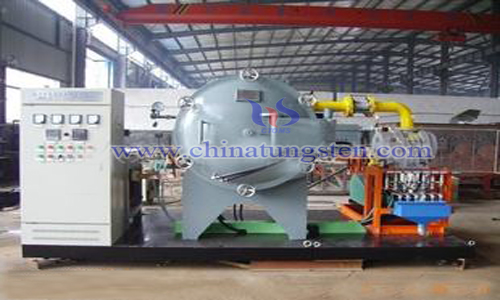Vacuum Low Temperature Sintering to Prepare Tungsten-Titanium Alloy
- Details
- Category: Tungsten Information
- Published on Friday, 31 May 2019 00:48
The tungsten-titanium (WTi) alloy as the copper wiring diffusion barrier sputtering target has strict requirements on the grain size of the internal structure. For the target of the same composition, the finer and uniform crystal grains, the faster the sputtering rate, the sputter deposition, the better uniformity of film thickness. Studies have shown that the smaller the grain size, the better the properties of the film produced. Therefore, controlling the grain size of the tungsten-titanium alloy target is one of the key factors for obtaining an excellent film.

At present, in order to obtain a fine grained WTi alloy target, a sintering method such as SPS, microwave sintering, hot isostatic pressing is usually employed. In the above various sintering methods, the sintering temperature is above 1300 ° C, and the higher sintering temperature makes the crystal grains easy to grow. However, although the hot isostatic pressing sintering temperature is low, the equipment used is expensive, and the requirements for equipment and operators are high. It has been shown that the lower the sintering temperature of the alloy, the less the content of the titanium-rich phase in the prepared alloy, and the smaller the number of particles produced by the coating. Therefore, reducing the sintering temperature of WTi alloy is a key factor in the preparation of fine-grained tungsten-titanium alloy. Some scholars have used vacuum low-temperature sintering to prepare tungsten-titanium alloy. The steps include:
Step 1, the tungsten powder with a particle size of 6-8 μm is placed in a ball mill tank, and 5% alcohol is added as a dispersing agent, and the WC grinding ball is added according to a ball to material ratio of 10-20:1, and then the ball mill tank is pre-drawn. After vacuum, argon gas is flushed, and the sealed ball mill tank is placed in a planetary high-energy ball mill for ball milling, the rotation speed is 400r/min, and the ball milling time is 6-15h;
Step 2, the ball-milled tungsten powder and the titanium hydride powder are mixed on a V-type mixer, and then the mixed powder is pressed into a green body on a TM-106 hydraulic press press at a pressure of 40 t;
Step 3, the green body pressed in step 2 is placed in a vacuum sintering furnace, vacuumed to 10-3 Pa, heated, heated to a temperature of 10 ° C / s to 500 ~ 600 ° C for 1 ~ 2 h, with furnace cooling , obtaining a sintered body of a WTi alloy;
Step 4, the sintered body of the WTi alloy obtained in the step 3 is placed in a stainless steel sheath, and then the jacket is vacuumed and welded, and the sintered body of the WTi alloy is wrapped with a sheath in an atmosphere protection furnace at 900 to 1000 ° C. Insulation for 1~2h, preheating the extrusion die, and then taking out the extrusion on a four-column three-beam hydraulic press at a pressure of 200t, the extrusion ratio is 16, the extrusion rate is 3mm/min, and the extruded WTi alloy After the quenching is taken out together with the wrap, the finished product is obtained.
The preparation method of fine-grained tungsten-titanium alloy is to carry out high-energy ball milling of W powder, increase defects in W and refine its crystal grains, which is beneficial to the diffusion of titanium into tungsten during high-temperature sintering, reducing the titanium-rich phase in the alloy and refining it. The grain of the alloy also reduces the sintering temperature of the alloy, reduces the fracture of the alloy during extrusion and the high temperature oxidation pollution caused by the manufacture of the alloy, and uses rapid quenching after extrusion to utilize the larger subcooling to refine the grain.
- Tungsten Alloy Manufacturer & Supplier, Chinatungsten Online: www.tungsten-alloy.com
- Tungsten News & Prices of China Tungsten Industry Association: www.ctia.com.cn
- Molybdenum News & Price: news.molybdenum.com.cn
- Tel.: 86 592 5129696; Fax: 86 592 5129797; Email: sales@chinatungsten.com



 sales@chinatungsten.com
sales@chinatungsten.com